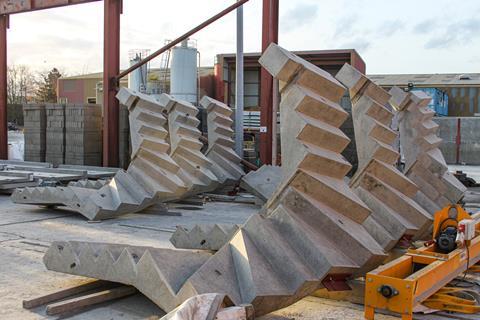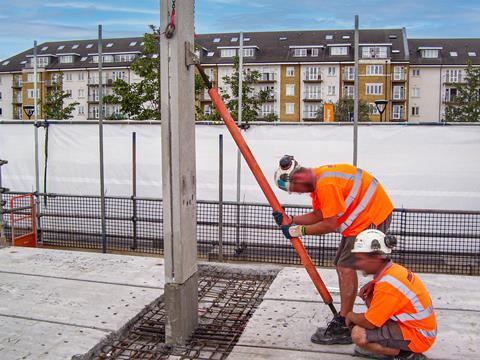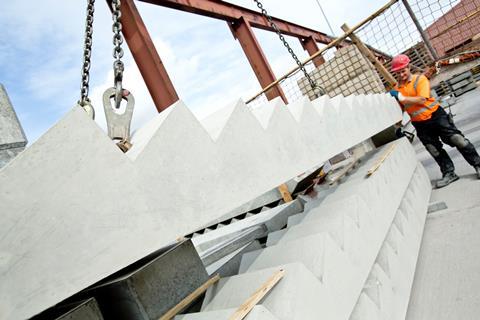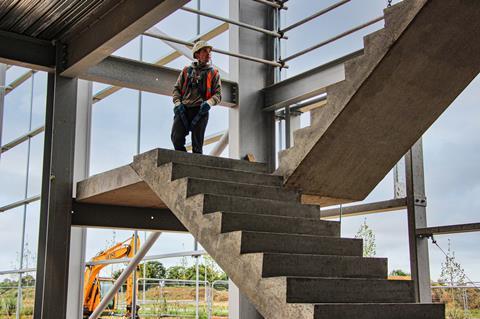Lee Cowen, managing director of Milbank Concrete Products, explores how innovations in precast concrete columns and stairs are transforming how the construction industry operates

Data from construction insights firm Glenigan reveals that the construction sector is on the verge of an expected period of growth, with predictions that the industry will see a 12% increase this year. However, budget and timescale demands within the sector are one of the most significant parameters which affect the efficiency of a project.
Meanwhile, the sector is facing a shift in building regulations prompted by safety concerns following the tragic Grenfell disaster of 2017.
Regulatory overhauls have spotlighted safety imperfections, particularly in high-rise residential constructions. This includes the changes to Approved Document B, mandating the inclusion of a second staircase in buildings over 18m tall.
Plus, there is the ever-present push towards more sustainable practices.
Ultimately, this combination is seeing construction businesses looking to adapt new ways of working to meet requirements. As the sector evolves in response to higher demands, regulatory changes and sustainability goals, the integration of precast concrete columns and stairs heralds a new era of efficiency, safety, and adaptability.

Below, managing director of Milbank Concrete Products, Lee Cowen, explores how innovations in precast concrete columns and stairs are transforming how the construction industry operates.
“In the current climate, developers are facing many pivotal decisions. As always, meeting timescales and budget constraints are a constant challenge.
Yet in the coming years additional layers of complexity and change will need to be considered as the industry addresses vital adaptations to building regulations from a safety and sustainability standpoint.
Moving forward, meeting sustainable goals through comprehensive legislation across scope 1, 2, and 3 is imperative.
By implementing stringent measures to reduce emissions, embracing renewable energy sources, optimising resource use, and promoting eco-friendly practices throughout the supply chain, the construction sector can pave the way towards a greener and more sustainable future.
The manufacture of precast concrete columns and stairs is helping lead the change through the implementation of environmentally friendly manufacturing and transportation practices. This includes utilising vehicles fuelled by HVO or electric power - substantially reducing carbon emissions by up to 90%.
Embracing sustainable energy solutions like solar panels and biomass boilers for heating curing processes is guiding concrete manufacturers towards achieving net zero objectives.
These initiatives, championed by Milbank Concrete Products, are propelling our business towards achieving net zero emissions for Scope 1 and 2 by 2030, surpassing the government target by 20 years.

Another notable change which is bubbling below the surface is the requirement for the inclusion of a second staircase in the construction of high-rise residential buildings.
These changes aim to enhance safety measures and mitigate risks in the event of emergencies, such as fires or evacuations. Once the transition phase has ended in September 2026, the updated regulations to Approved Document B will mean that all buildings over 18m tall would require the installation of a second staircase.
So, what does this mean for project managers and the supply chain?
Ultimately, they will need to weigh up their options to ensure they adhere to evolving regulations while minimising disruptions to ongoing and future projects. In navigating these changes, the choice of materials and construction methods plays an important role.
For high-rise construction projects, we are seeing an emerging trend in the form of precast concrete products as project managers try to stay ahead of the curve.
For example, precast concrete stairs are designed for swift installation, reducing labour costs and construction time with the added benefit of enabling the workforce easy access to different levels.

Their modular nature allows for seamless integration into building structures, facilitating compliance with the new requirement for a second staircase.
Additionally, precast concrete stairs can withstand heavy foot traffic, ensuring long-term safety and structural integrity.
On the other hand, precast concrete columns are suitable for supporting heavy loads and withstanding various environmental conditions.
Known for their high strength, superior finish and durability, precast concrete columns achieve a much higher early strength at the point of delivery, and they provide enhanced fire protection when compared to steel columns.
Not only this, the use of precast concrete columns has been proven to reduce the labour requirements on-site, minimise material waste, limit vehicles and deliveries required on-site, and reduce the cost and time of crane requirements.

Manufactured in controlled environments, precast concrete columns and stairs exhibit a high level of consistency in terms of dimensions, quality, and appearance. They can also be manufactured bespoke to the individual project.
Their off-site fabrication minimises on-site disruptions, accelerates construction timelines, and aligns seamlessly with regulatory mandates.
In addition, the manufacturing process also mitigates the impact of adverse weather conditions on the construction process. For instance, traditional in situ column casting methods require four times the crane lift time and are susceptible to wind interference.
Additionally, cold weather affects concrete pouring and prolongs curing times, factors that are lessened through off-site manufacturing.

The construction sector is undergoing a significant transformation. Whether it’s cost constraints, reduced timescales, regulatory amendments or sustainability goals, the long-term priorities of developers and project managers needs to encompass multiple layers of change.
However, this transition to new working practices doesn’t need to be challenging. Precast concrete columns and stairs offer a solution which efficiently meets these needs, helping to futureproof projects as these changes come to the forefront.”
Find out more about how our range could support your projects by speaking to one of the experts at Milbank Concrete Products today.


























